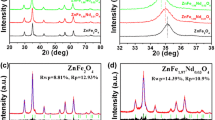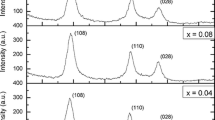Abstract
The crystal structure, electromagnetic properties and magnetocaloric effect (MCE) of ternary iron-based ZnFe3N nitride have been investigated systematically. The density of states (DOS) calculation combined with theoretical model analysis suggests that ZnFe3N has a second-order ferromagnetic phase transition process existing in the cubic system. Its saturation magnetization (Ms) is about 108.3 emu/g at 5 K. The maximum values of magnetic entropy change (|ΔSM| = 2.2984 J/kg K) and relative cooling power (RCP = 247.0671 J/kg) are calculated from the measurements at a magnetic field change ΔH = 50 kOe, respectively.









Similar content being viewed by others
References
E. Warburg, Magnetische untersuchungen. Ann. Phys. 13(141), 569 (1881)
A.M. Tishin, Y.I. Spichkin, The magnetocaloric effect and its applications (Institute of Physics Publishing, Bristol, 2003)
V.K. Pecharsky, K.A. Gschneidner Jr., Magnetocaloric effect and magnetic refrigeration. J. Magn. Magn. Mater. 200(1–3), 44–56 (1999)
A. Smith et al., Materials challenges for high performance magnetocaloric refrigeration devices. Adv. Energy. Mater. 2(11), 1288–1318 (2012)
K.A. Gschneidner Jr, V.K. Pecharsky, A.O. Tsokol, Recent developments in magnetocaloric materials. Rep. Prog. Phys. 68(6), 1479 (2005)
E. Brück, Developments in magnetocaloric refrigeration. J. Phys. D Appl. Phys. 38(23), R381 (2005)
V. Provenzano, A.J. Shapiro, R.D. Shull, Reduction of hysteresis losses in the magnetic refrigerant Gd5Ge2Si2 by the addition of iron. Nature 429(6994), 853 (2004)
K.A. Gschneidner Jr., Vitalij K. Pecharsky, Magnetocaloric materials. Annu. Rev. Mater. Sci. 30(1), 387–429 (2000)
B.S. Wang et al., Structural, magnetic, electrical transport properties, and reversible room-temperature magnetocaloric effect in antipervoskite compound AlCMn3. J. Appl. Phys. 108(9), 093925 (2010)
D. Boldrin et al., Multisite exchange-enhanced barocaloric response in Mn3NiN. Phys. Rev. X. 8(4), 041035 (2018)
S. Suetsugu et al., Magnetotransport in Sr3PbO antiperovskite. Phys. Rev. B. 98(11), 115203 (2018)
S. Lin et al., Critical behavior in the itinerant ferromagnet AsNCr3 with tetragonal-antiperovskite structure. Phys. Rev. B. 98(1), 014412 (2018)
Y.B. Li et al., Magnetic, transport and magnetotransport properties of Mn3+xSn1−xC and Mn3ZnySn1−yC compounds. Phys. Rev. B. 72(2), 024411 (2005)
S. Lin et al., Composition dependent-magnetocaloric effect and low room-temperature coefficient of resistivity study of iron-based antiperovskite compounds Sn1−xGaxCFe3 (0 ≤ x ≤ 1.0). Appl. Phys. Lett. 99(17), 172503 (2011)
S. Lin et al., The magnetic, electrical transport and thermal transport properties of Fe-based antipervoskite compounds ZnCxFe3. J. Appl. Phys. 110(8), 083914 (2011)
B.S. Wang et al., Reversible room-temperature magnetocaloric effect with large temperature span in antiperovskite compounds Ga1−xCMn3+x (x = 0, 0.06, 0.07, and 0.08). J. Appl. Phys. 105(8), 083907 (2009)
S. Lin et al., The structural, magnetic, electrical/thermal transport properties and reversible magnetocaloric effect in Fe-based antipervoskite compound AlC1.1Fe3. J. Magn. Magn. Mater. 324(20), 3267–3271 (2012)
S.J. Clark et al., First principles methods using CASTEP. Z. Für Kristallogr. Cryst. Mater. 220(5/6), 567–570 (2005)
J.P. Perdew, K. Burke, M. Ernzerhof, Generalized gradient approximation made simple. Phys. Rev. Lett. 77(18), 3865 (1996)
J.D. Pack, H.J. Monkhorst, Special points for Brillouin-zone integrations—a reply. Phys. Rev. B. 16(4), 1748 (1977)
Y.R. Jang, I.G. Kim, J.I. Lee, Electronic structure and magnetic properties of Fe4N (0 0 1). J. Magn. Magn. Mater. 263(3), 366–372 (2003)
M. Sifkovits et al., Interplay of chemical bonding and magnetism in Fe4N, Fe3N and ζ-Fe2N. J. Magn. Magn. Mater. 204(3), 191–198 (1999)
E.L. Blancá, Y. Peltzer et al., The magnetization of γ′-Fe4N: theory versus experiment. Phys. Status Solidi B 246(5), 909–928 (2009)
P. Monachesi et al., Electronic structure and magnetic properties of Mn Co, and Ni substitution of Fe in Fe4N. Phys. Rev. B 88(5), 054420 (2013)
A.V.G. Rebaza, J. Desimoni, E.L. Peltzer, Blancá, Study on the oscillatory behaviour of the lattice parameter in ternary iron–nitrogen compounds. Phys. B 407(16), 3240–3243 (2012)
D. Music et al., Thermal expansion and elasticity of PdFe3N within the quasiharmonic approximation. Eur. Phys. J. B 77(3), 401–406 (2010)
P. Mohn et al., Calculated electronic and magnetic structure of the nitrides NiFe3N and PdFe3N. Phys. Rev. B 45(8), 4000 (1992)
C.A. Kuhnen, A.V. Dos Santos, Ground-state and thermal properties of substituted iron nitrides. J. Alloys. Compd. 279(1–2), 68–72 (2000)
J. Von Appen, D. Richard, Predicting new ferromagnetic nitrides from electronic structure theory: IrFe3N and RhFe3N. Angew. Chem. Int. Ed. 44(8), 1205–1210 (2005)
D. Music, J.M. Schneider, Elastic properties of MFe3N (M = Ni, Pd, Pt) studied by ab initio calculations. Appl. Phys. Lett. 88(3), 031914 (2006)
T. Scholz, A. Leineweber, R. Dronskowski, Comment on “High-temperature soft magnetic properties of antiperovskite nitrides ZnNFe3 and AlNFe3. J. Magn. Magn. Mater. 416, 475–476 (2016)
B.K. Banerjee, On a generalised approach to first and second order magnetic transitions. Phys. Rev. Lett. 12, 16–17 (1964)
M. Iqbal, M.N. Khan, A.A. Khan, Structural, magnetic, magnetocaloric and critical behavior studies in the vicinity of the paramagnetic to ferromagnetic phase transition temperature in LaMnO3+δ compound. J. Magn. Magn. Mater. 465, 670–677 (2018)
T. Tohei, H. Wada, T. Kanomata, Negative magnetocaloric effect at the antiferromagnetic to ferromagnetic transition of Mn3GaC. J. Appl. Phys. 94(3), 1800–1802 (2003)
M.-H. Phan, Y. Seong-Cho, Review of the magnetocaloric effect in manganite materials. J. Magn. Magn. Mater. 308(2), 325–340 (2007)
V. Franco, J.S. Blázquez, A. Conde, Field dependence of the magnetocaloric effect in materials with a second order phase transition: a master curve for the magnetic entropy change. Appl. Phys. Lett. 89(22), 222512 (2006)
R. Zeng et al., Magnetic properties and magnetocaloric effect of (Mn1-xNix)3Sn2 (x = 0–0.5) compounds. J. Appl. Phys. 105(7), 07A935 (2009)
M.A. Hamad, Prediction of thermomagnetic properties of La0.67Ca0.33MnO3 and La0.67Sr0.33MnO3. Phase Trans. 85(1–2), 106–112 (2012)
C.L. Zhang et al., Large magnetic entropy changes in Gd–Co amorphous ribbons. J. Appl. Phys. 105(1), 013912 (2009)
X.C. Kan et al., Magnetic and structural phase diagram of antiperovskites ZnCFe3−xCox (0 ≤ x ≤ 3): the combined negative magnetoresistance and large room-temperature magnetocaloric effect in x = 0.5. J. Alloys. Compd. 693, 895–901 (2017)
B.S. Wang et al., Structural, magnetic properties and magnetocaloric effect in Ni-doped antiperovskite compounds GaCMn3−xNix (0 ≤ x ≤ 0.10). Physica B. 405(10), 2427–2430 (2010)
Acknowledgements
This study was funded by the National Natural Science Foundation of China (Grant Nos. 51802002 and 51872004), Anhui Department of Education Foundation (Grant Nos. KJ2018A0039) and the Key Program of the Science and Technology Department of Anhui Province (Grant Nos. S201904a09020074), China. This work was also supported by High-Performance Computing Platform of Anhui University, China.
Author information
Authors and Affiliations
Corresponding authors
Ethics declarations
Conflict of interest
The authors declare that there is no conflict of interest.
Rights and permissions
About this article
Cite this article
Wang, W., Kan, X., Liu, X. et al. Effect of zinc substitution on crystal structure and magnetocaloric properties of ZnFe3N nitride. Eur. Phys. J. Plus 135, 505 (2020). https://doi.org/10.1140/epjp/s13360-020-00512-7
Received:
Accepted:
Published:
DOI: https://doi.org/10.1140/epjp/s13360-020-00512-7




